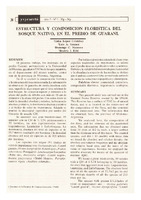| dc.creator | López Cristóbal, Lidia Mirta | |
| dc.creator | Grance, Luis Alberto | |
| dc.creator | Maiocco, Domingo César | |
| dc.creator | Eibl, Beatriz Irene | |
| dc.date.accessioned | 2022-08-24T18:08:19Z | |
| dc.date.available | 2022-08-24T18:08:19Z | |
| dc.date.issued | 1996-05-01 | |
| dc.identifier.citation | López Cristóbal, L., Grance, L. A.,Maiocco, D. C., y Eibl, B. I. (1996). Estructura y composición florística del bosque nativo, en el predio de guaraní. Yvyraretá: Revista Forestal País de Árboles. Eldorado (Misiones): UNaM. FCF; (7), pp. 30-38. | es_AR |
| dc.identifier.issn | 0328-2236 | |
| dc.identifier.other | Yvy-238 | |
| dc.identifier.uri | https://hdl.handle.net/20.500.12219/3394 | |
| dc.description | Fil: López Cristóbal, Lidia Mirta. Universidad Nacional de Misiones. Facultad de Ciencias Forestales; Argentina. | es_AR |
| dc.description | Fil: Grance, Luis Alberto. Universidad Nacional de Misiones. Facultad de Ciencias Forestales; Argentina. | es_AR |
| dc.description | Fil: Maiocco, Domingo Cesar. Universidad Nacional de Misiones. Facultad de Ciencias Forestales; Argentina. | es_AR |
| dc.description | Fil: Eibl, Beatriz Irene. Universidad Nacional de Misiones. Facultad de Ciencias Forestales; Argentina. | es_AR |
| dc.description.abstract | El presente trabajo fue realizado en el predio guaraní, perteneciente a la Universidad de Misiones, que abarca 5342ha de bosques naturales, en el departamento del mismo nombre , centro este de la Provincia de Misiones, Argentina.
En él se analizó la composición florística y la estructura del área mencionada. La información se obtuvo de 34 parcelas de media hectárea cada una, superficie algo mayor que el área minima de este bosque. Se censaron especie y diámetro a la altura del pecho de arboles con mas de 10cm de diámetro a la altura del pecho. Con estos datos se halló la densidad absoluta y relativa, la frecuencia absoluta y relativa, la denominación absoluta y relativa y el índice valor de importancia. Además se analizó la diversidad específica por medio del coeficiente de mezcla CM.
Se encontró una gran biodiversidad, 89 especies con un CM de 1: 3,54, perteneciente a 30 familias, las más representadas fueron: Leguminosas, Lauraceas y Euforbiaces. La denominación absoluta del total de especies es de 23, 7 metros cuadrados por hectáreas y la densidad absoluta del total de especies es de 315 árboles por hectáreas
Las especies con mayor IVI (indice de valor de importancia) son: Ocotea puberula “Laurel Ayuí”, Prunus subcoriácea “Persiguero”, Lonchocarpus leucanthus “Rabo itá”, Nectandra saligna ”Laurel Negro”, Ateleia glazioviana “Timbó blanco”, Parapiptandenia rigida “Anchico colorado”.
Por hallarse presentes además de estas otras especies madarables importancia, se infiere que el predio tiene un significativo valor económico.
Debido a la variabilidad encontrada para la densidad y la abundancia respecto de las medias se deduce que el análisis estructural debe ser realizado teniendo en cuenta las variaciones topográficas y edafológicas. | es_AR |
| dc.description.abstract | This present study was carried out in the Guaraní forest reserve, owned by the UNaM.
This reserve has Surface of 5342 ha of natural forests, and it is located in the center-east of the composition of the flora, and the structure of the mantioned área. The information that
We obtained here,the Province of Misiones, Argentina.
We analysed, here, the composition of the flora, and structure of the mentioned área. The information that we obtained came from 34 plots of ½ ha each, a larger Surface that the minimum area of this forest.We counted species, and dbh (10 cmdbh) with these data we found the absolute and relative density, the absolute and relative frequency and the
absolute and relative basal área, and index of the value importance. Besides, we analysed the specifie diversity by means of the quotient of mixture (QM).
We found a great biodiversity, 89 species with a QM of 1: 3.54, belonging to 30 families, the ones that appeared most were: Leguminosae, Laureceae and Euforbiaceae. The absolute basal área all the species is 23.7 m2 per ha and the absolute density of all the species of 315 trees per ha.
The species with the highest I.V.I (index of value of importance) are: Ocotea puberula "Laurel guaicá", Ocotea dyospirifolia “Laurel ayuí”, Prunus subcoriácea "Persiguero", Lonchocarpus leucanthus "Rabo itá", Nectandra saligna "Laurel negro", Ateleia glazioviana "Timbó blanco", Parapiptandenia rigida "Anchico colorado".
As we found other species of comercial importance, we infer that the land has a significant economic value. Due to the variability found according to the density and the abundance with respect to the mean, we deduce that the structural analysis must be done taking into account the topographic and soil variations. | en |
| dc.format | application/pdf | |
| dc.format.extent | 3.580 MB | |
| dc.language.iso | spa | es_AR |
| dc.publisher | Universidad Nacional de Misiones. Facultad de Ciencias Forestales. Instituto Subtropical de Investigaciones Forestales | es_AR |
| dc.relation | info:eu-repo/semantics/altIdentifier/urn/http://www.yvyrareta.com.ar/index.php/item/347-may-1996-n-7 | |
| dc.rights | Atribución-NoComercial-CompartirIgual 4.0 Internacional | |
| dc.rights | info:eu-repo/semantics/openAccess | |
| dc.rights.uri | http://creativecommons.org/licenses/by-nc-sa/4.0/ | |
| dc.subject | Comunidad | es_AR |
| dc.subject | Estructura | es_AR |
| dc.subject | Composición florística | es_AR |
| dc.subject | Importancia ecológica | es_AR |
| dc.subject | Community | en |
| dc.subject | Structure | en |
| dc.subject | Flora composition | en |
| dc.subject | Ecologic importance | en |
| dc.title | Estructura y composición florística del bosque nativo, en el predio de guaraní | es_AR |
| dc.type | info:eu-repo/semantics/article | |
| dc.type | info:ar-repo/semantics/artículo | |
| dc.type | info:eu-repo/semantics/publishedVersion | |




